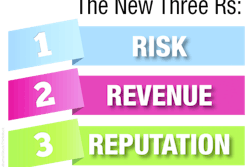Risk management’s significance has been on the rise in the supply chain not only because its effects can be swift, but also direct and far-reaching. Supply chain disruptions occur on a daily basis around the globe—from tsunamis to power outages to suppliers going out of business to political turmoil to labor strikes to regulatory restrictions—the list could go on infinitely as supply chain leaders can never perfectly anticipate the disruption, its severity or the potential impact on business.
Complexity
Businesses are also dealing with surging complexity in terms of their supply chains and the global footprint in which many are working. The global marketplace can be a boon to business, saving on labor cost and expanding market reach, but on the other hand, there are certain downfalls that can come with the territory. With every new region in which a business operates, there are differing regulations that must be monitored, disparate data systems that must be integrated, and generally, more complexity that must be managed.
According to Bob Farrell, the president and CEO of Kewill, “The complexity increase relates to people looking at the supply chain as no longer just a cost of doing business, but a strategic imperative—one in which they either get a competitive or operative advantage that allows them to drive more profit. While managing risk has always been an inherent part of the supply chain, it really has never became more so than with the global extended supply chain. With the number of supply chain trading partners that people work with, their desire to create more complex products and move things more efficiently, coupled with increases in the number of, time zones and culture, it becomes very risky.
“When I take a circuitous way home from work, the likelihood of me getting lost is much higher than taking the highway that I always take. It’s the same thing with supply chain. That ability to manage risk is what allows certain organizations to differentiate themselves. If you can deal with complexity, you can become more operatively efficient and drive more profit, which makes you more valuable. Depending on the kind of business you are, when you can demonstrate to your customers that you can deal with complexity in a better way, you’re going to be more successful.”
“That’s why risk management is a high priority. If you get it right and start to manage risk correctly, and make it part and parcel of what you do as opposed to being reactive, you could really change the face of your business.”
Quality
Farrell thinks that data quality issues, in particular, expose the supply chain to weakness. Because the supply chain relies so heavily on data, which when extrapolated leads to visibility and better risk management, one problem can intensify exponentially downstream. He says, “Data quality is made more difficult as you have a lot of information being passed manually, and entered and re-entered into disparate systems multiple times. Even if you have full electronic integration of data across the supply chain partners you have, you need to make sure the mapping is correct.”
Yet data availability and accurate data are key to effectively mitigating the risk of a supply chain disruption. Farrell says, “It’s easier to recover when you know where the inventory information is across the network and where in transit various goods are.” The ability to use that data to create visibility into your potential options is paramount when it comes to “redirecting that inventory or using different transport sources or performing certain modeling in terms of which options may cost the most or take the most time. A lack of visibility of status of orders in the supply chain is a risk across the end-to-end supply chain and supply chain process, and minimizes your ability to react in a timely fashion. Being able to share events and alerts allow businesses to address risks and mitigate them as they’re going on.”
Because visibility allows you to track what’s happening across the supply chain, it mitigates your risk exposure, and therefore your vulnerability, because your business can act proactively as opposed to reactively. Data integration can help spur and expand that visibility, giving you a better view of your supply chain, independent of what applications you use, what technology you use and whom your supply chain partners are. As businesses become more global, Farrell says, it behooves companies to implement a platform that addresses the complete supply chain and all of its components.
“When companies are looking at mitigating risk in the supply chain, using platform solutions that deal with all of the key functions within the supply chain, whether that be the trade, storage, transportation management, compliance, overall management (the ability to integrate with SAP or homegrown systems), having visibility over all of that” offers businesses the opportunity to mitigate risk, and deal with the issues around data quality, visibility and people.
However, software and applications are only as good as the way that they are implemented and used. According to Farrell, “There are redundancies you need to have in terms of physical data centers and hardware and software. If you’re going to effectively manage risk, then you have to know how to do what you do independent of your systems and your data in case your physical assets aren’t available to you.”
Compliance
Regulations impact the global—and even local—supply chain on an almost daily basis. Farrell says that making sure you’re in compliance, and even dealing with the right authorities and jurisdictions around the world can be tough: “Making sure that all your orders flow through the supply chain, and that the physical movement and storage of goods follow legislative and industry self-regulating guidelines is difficult. Sometimes, acts of compliance come down to making sure some of the manual processes are followed correctly. Sometimes it’s easier to deal with electronic processes, which makes doing some things in a timely fashion easier, but there are a lot of physical things that go along with it. Having a process environment, one that requires you to input into a system what is going on every step of the way, can really help mitigate that.”
He continues, “It’s amazing how much institutional knowledge certain individuals have and how reliant organizations are on those people to be able to make sure things are done in a way to minimize risk. Those people can walk out the door and the intellectual capital that they have goes out the door with them. Even those supply chains that are highly automated are reliant on human interaction, which can work positively and negatively. If you force things through a process management environment that has gatings, you can eliminate a lot of risk.”
Farrell suggests using solutions that help implement the necessary checkpoints to reduce the risk around regulatory and corporate compliance; establishing internal working groups that analyze potential weak points; performing modeling around potential options that can be taken; and developing standard operating procedures around people, processes, systems methodology and best practices.












